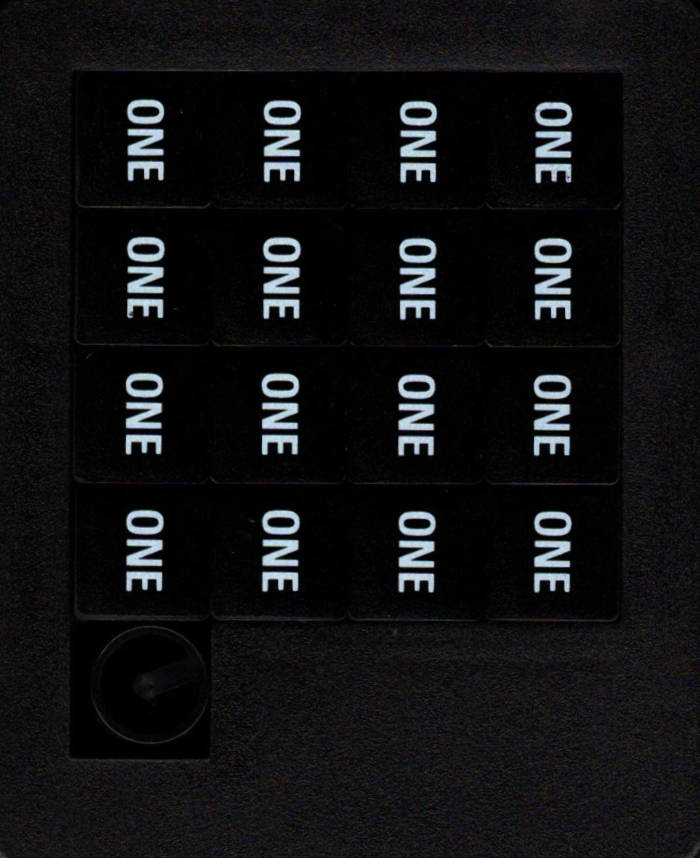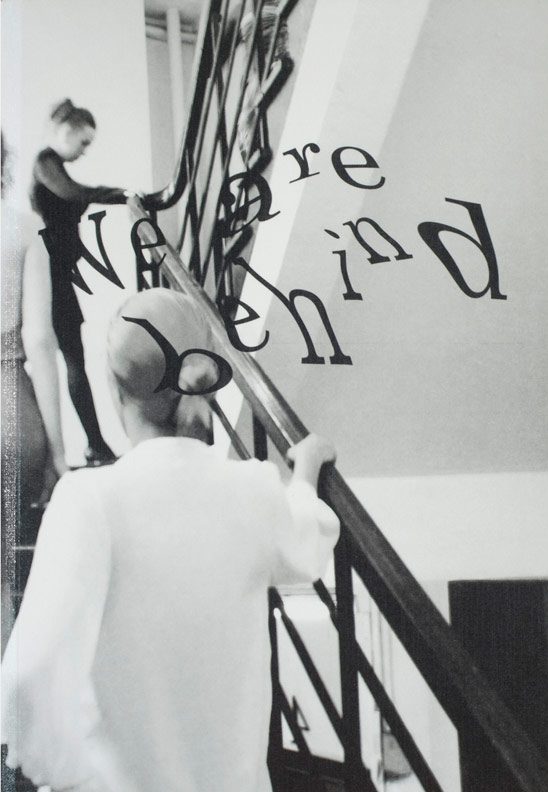Dan Graham
Dan Graham

Some Rockin' – Dan Graham Interviews
A collection of Dan Graham's interviews and conversations with a wide array of individuals from various backgrounds and disciplines.
Dan Graham was a contrarian. His art confronted viewers with a multiplicity of possible perceptions and intersubjective experiences. Some Rockin' was his last project and—through conversations with friends, artists, architects, curators, and former assistants—articulates his sensitivity to context, media, and people. The interviews address rock music and urbanism, humor and astrology, history and the hybrid form. Mediating historical and social experience was a major concern of his. "The Museum in Evolution," an essay he finished just before his death, and published here, highlights that nothing is final in becoming. Rather, it allows for: Some Rockin'.

ONE
‘One’ is Dan Grahams version of the classic sliding game. However playing this particular game has only one possible outcome. The multiple consists of sixteen movable squares printed white on black bricks in a black plastic housing.
Second edition of 1000 copies
7.4 x 9 x 0.7 cm

Dan Graham: Theatre
A facsimile of Graham's ultra-rare artist's book documenting early performance works.
Originally published in 1978 and produced here in facsimile form, Theatre is an artist's book documenting seven early performance works by Dan Graham (born 1942) taking place from 1969 to 1977, with notes, transcripts and photo documentation for each performance. These performances catch the artist at a unique moment, as he shifts away from his early media works and towards his hallmark video and written work around underground music and youth culture.
The works in Theatre focus primarily on the psychological and social space between individuals and the roles they serve inside the arena of performance, subverting them by creating conditions by which a performer or audience simultaneously functions as both (creating a type of feedback loop through social transgression). Like most of Graham's work, these performances also serve as a critique of cultural norms, with many of the performances utilizing quotidian, social acts that are amplified over time.
And more

Paradis catalogue
Contributions by: Nicole-Antonia Spagnola, Georgia Sagri, John Kelsey, Matthew Pang, Cathy Wilkes, Sarah Rapson, Nick Irvin, Gene Beery, Anne Dressen, Anne Pontégnie, Jacqueline Mesmaeker, Sara Deraedt, Anne Rorimer, Kari Rittenbach, Olga Balema, Maria Nordman, Louise Lawler, Julie Ault, Martin Beck, Adrian Morris, Matt Browning, John Miller, Envers Hadzijaj, Enzo Shalom, Bedros Yeretzian, Morag Keil, Helmut Draxler, Gianna Surangkanjanajai, Steve Cannon, Rae Armentrout, Zoe Hitzig, Pierre Guyotat, Lola Sinreich, Fanny Howe, Hélène Fauquet, Marie Angeletti, Richard Hawkins, Andy Robert, Alexander García Düttmann, Daniel Horn, El Hadji Sy, Henrik Olesen, Aurélien Potier, Richard John Jones, Stéphane Barbier Bouvet, Nora Schultz, Peter Fend, Megan Francis Sullivan, Jill Johnston, Sturtevant, Tonio Kröner, Bernard Bazile, Pierre Bal-Blanc, Jérome Pantalacci, Gérard Traquandi, Gladys Clover, Maria Wutz, Jimmie Durham, Richard Sides, Camilla Wills, Michael Callies, Steven Warwick, Matthew Langan-Peck, Dan Graham, Nina Könnemann, Hans Christian Dany, Valérie Knoll, Win McCarthy, Eleanor Ivory Weber, Anna Rubin, Heji Shin, Michèle Graf & Selina Grüter, Inka Meißner, Simone Forti, Morgan O’Hara, Angharad Williams, Ye Xe, Lily Van Der Stokker, Yuki Kimura, Peter Wächtler, Eva Steinmetz, Michael Van den Abeele, Marc Kokopeli, Bradley Kronz, Robert Grosvenor, Samuel Jeffery, Charlotte Houette, Adam Martin, Wade Guyton, Chloe Truong-Jones.
Edited by Marie Angeletti with Gianmaria Andreetta and Camilla Wills.
Printed in December 2022.
416 pages, Edition of 840.
© 2022 Claude Balls Int. / the author(s).

Utopia
A collection of texts defining utopia as a place existing only within the domain of language, Utopia gives a synthesis of historical utopias and a snapshot of the 1970-1980's poetic scene.
An avant-garde writer associated with the New York School of poets, Bernadette Mayer was born in 1945 in Brooklyn, New York, where she lives and works. From 1967 to 1969, she published the experimental newspaper 0 to 9 with artist Vito Acconci, which combined texts and works of writers and conceptual artists based on the use of language (Ted Berrigan, Clark Coolidge, Hannah Weiner, Aram Saroyan, Robert Smithson, Dan Graham, Morton Feldman or Sol LeWitt).
In 1967—along with Lewis Warsh—she founded the publishing house United Artists Books which published a number of influential writers such as Robert Creeley, Anne Waldman, Hannah Weiner, James Schuyler, Ted Berrigan and Alice Notley as well as Mayer's own books like 1978's The Golden books of Words or 1984's Utopia. Known for her innovative use of language, Mayer rose to prominence with the exhibition “Memory,” which combined photography and narration. During July 1971 Mayer took daily photographs and recorded her thoughts. These materials formed the basis for the exhibition, and for the eponymous book published in 1975. In 1980, Mayer became director of the Poetry Project at St. Mark's Church in New York where she also ran literary workshops. She also initiated the Poetry Project's Reading Series.
Mayer's composition methods such as chance operation, collage and cut-up identifies her as being close to the likes of John Cage, Jackson Mac Low or Frank O'Hara—central figures of the New York School—as well as more contemporary figures associated with the magazine L=A=N=G=U=A=G=E. Mayer's work is also influenced by modernist figures such as James Joyce, Gertrude Stein and the Dadaists or classical authors (Catullus).
French Edition.
Published in June 2016.

We are behind
Presented as the blueprints for three public lectures, We are behind proposes alternative routes through Emily Wardill’s work and represents three different attempts at embodying and dissembling knowledge. Using different formal textual devices, from which they also deviate – a standard lecture, the subject of which becomes something felt, not taught; an a-chronological conversation; and the transcript of a play rendered as a formal essay – each section describes the different facets of an ongoing dialogue between the authors. Fragmented not only by dialogic turns, appropriated texts, images, a score and quotations, and containing extensive reproductions of Wardill’s work, the book’s content and design reflects the labyrinthine, and sometimes hallucinogenic quality of her films and their radical combination of form, content and idea.
Each section focuses on specific works. Section One, The Object, uses The Diamond (Descartes Daughter), SEA OAK, and Gamekeepers without Game, to explore ideas of the rational, public art, the public, linguistic framing and the irrational, via Gladys Knight and the Pips, a hand-drawn hallucinogenic section, Seth Price’s essay Dispersion, Norman Mailer, The Rockridge Institute and Peter Gidal. Section Two, The Window follows a conversations between the authors, that opens onto desire, politics, mirrors, and the films Basking in what feels like ‘An Ocean of Grace’ I soon realise that I am not looking at it but rather, I AM it, recognising myself, Split the View in Two (Part Two), and Sick Serena and Dregs and Wreck and Wreck. In the final part, The Theatre, an apparently formal essay on the implications of framing live action, the proscenium arch as a link between theatre and cinema, Dan Graham, perspective, power and its collapse, transforms into a collection of dialogues around Ben, Sick Serena and Dregs and Wreck and Wreck, authenticity, reality and fiction.